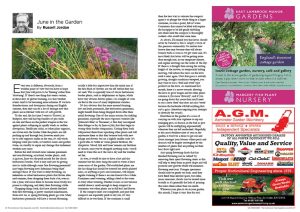
Every year is different, obviously, from a weather point of view but you have to hope that June will prove to be ‘flaming’ rather than ‘drowning’. If there’s one thing that seems certain, in these days of global warming, it is that weather events tend to be becoming more extreme. If we have thunderstorms and downpours during our English summer, then they can do a lot of damage now that plants are in full leaf with lots of soft growth.
To this end, the last time I went to ‘Groves’, in Bridport, they still had big bundles of pea sticks on sale and these are the perfect weapon in the war against plants collapsing in squally winds or sudden downpours. Ideally pea sticks, or other plant supports, are woven into the border while the plants are still pushing up and through but, however much you try to add supports earlier in the year, it’s still worth keeping some pea sticks, or bamboo canes and garden twine, on standby to repair any damage that inclement weather may cause.
Before the shift towards later summer perennials and non-flowering, structural, border plants, such as grasses, June was the peak month for the classic herbaceous border. Now it may only just be getting into its stride although some ‘late flowering perennials’ may begin flowering now; heleniums being chief amongst these. If you want to delay flowering, on heleniums or other herbaceous plants that flower after mid-summer, then chopping them back a bit, even as late a June, will cause them to become more bushy, less prone to collapsing, and delay their flowering a little.
Chopping things back, that have already finished their first flowering, is pretty standard maintenance, from now on, as spring flowering plants go over. Many herbaceous perennials will have a second blooming, usually a little less impressive than the initial one, if the first flush of flowers are cut off before they can set seed. This is especially true of classic herbaceous border plants, such as delphiniums or lupins, which have very obvious flower spikes—to a height of over six feet in the case of many delphinium varieties.
It’s less obvious that the more mound forming, low and leafy, perennials, like herbaceous geraniums, might benefit from being chopped down after their initial flowering. One of the major reasons for tackling geraniums, especially the most vigorous varieties like ‘Johnson’s Blue’ or ‘Rozanne’, is that they can expand their foliage so far, by June or July, that they begin to swamp their border companions. Cutting them back will prevent them from squashing other plants and will rejuvenate them so that they bounce back with new foliage and flowers but on a slightly smaller scale. It’s a good idea to ‘tickle in’ some general fertiliser, the ubiquitous ‘blood, fish and bone’ remains my fertiliser of choice, once you’ve chopped anything back—you’ll need to water this in if the soil is dry and the weather set fair.
As ever, it would be nice to have a hot and dry summer but this does bring the need to water at least some areas of the garden. Old established plants are the last thing that should be watered but newly planted areas, or anything in pots and containers, will require regular watering if there is no rain forecast for a while. Containers need watering, adding a feed to the water at every other watering, whether it rains or not because rainfall alone is rarely enough to keep compost in containers wet when plants are in full leaf and flower.
If the compost dries out completely, and peat-free composts are especially quick to dry out, it’s very difficult to re-wet them. If the container is small then the best way to saturate the compost again is to plunge the whole thing in a larger container, or even a pond, full of water. Containers that cannot be lifted will require the hosepipe to be left gently dribbling into them until the compost is thoroughly soaked—this could take some time.
As always, I’ll remind you that lawns should never be watered as this is simply a waste of this precious commodity. No matter how brown they may become they will always bounce back as soon as we get some rain. It’s most likely that lawns will be getting more than enough rain. in our temperate climate, and regular mowings are the order of the day. If there is a drought then raising the cutting height of the mower, or temporarily halting mowing, will reduce the stress on the lawn until it rains again. Now that grass is actively growing, drought conditions excepted, you may want to use a ‘feed and weed’ type product on the lawn. As mentioned last month, there is a move towards allowing the lawn to grow longer and let other plants colonise it, for more ‘diversity’, and if you are going down this route then you’ll need to use a lawn ‘feed’ that does not also ‘weed’ because the herbicide will kill anything that isn’t a grass (therefore negating your attempts to diversify the sward!).
Elsewhere in the garden it’s a case of carrying on with your vigilance to nip any emerging pest, or disease, in the bud as pest species will be multiplying exponentially wherever they are left unchecked. Hopefully, at this most ebullient time of year in the garden, it won’t be a chore to get out and about amongst your blooms where pests and diseases will be hugely outweighed by the number of plants that are putting on their best show right now.
Any spring flowering shrub that has finished flowering can be ‘edited’ by removing their spent flowering stems as this will help to keep them in good shape and will promote new growth which will maximise flowering next year. Younger specimens should only be gently cut back. until they have filled their allotted space, but older, more senescent, shrubs can be treated more brutally as it’s generally the lack of pruning that ruins them rather than too much.
Whatever your plan to do in your garden this month, I hope it stays fine for you!




